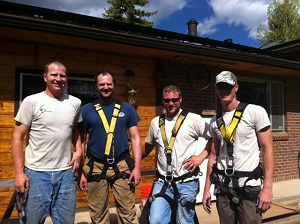Residential solar installation from installer's perspective
 Recently, Clean Energy Authority had a chance to catch up with solar installers from Namasté Solar as they installed a roughly 6.5-kilowatt array on Tom and Barbara Jean Gard’s home in Evergreen, Colo. Namasté is an employee-owned company, with roughly 60 employee-owners, operating out of Boulder, Colo. It’s received praise from President Barack Obama, among others.
Recently, Clean Energy Authority had a chance to catch up with solar installers from Namasté Solar as they installed a roughly 6.5-kilowatt array on Tom and Barbara Jean Gard’s home in Evergreen, Colo. Namasté is an employee-owned company, with roughly 60 employee-owners, operating out of Boulder, Colo. It’s received praise from President Barack Obama, among others.
Namasté serves both residential and commercial markets, said Jim Bakhaus, one of the installers putting in the array on the Gards’ home. “One interesting thing about this system is it’s leased,” Bakaus said. “If it was just customer-owned, it would cost somewhere between $25,000 and $30,000.”
Namasté, however, does not supply the lease.
“I’d say over half of our customers lease their system through a third-party financing company called SunRun,” Bakaus said. “How it works is the customer pays SunRun a monthly payment, and SunRun in turn pays us the upfront costs [of purchasing and installing the system], and the customer pays out the cost of their system over a series of 15 to 20 years.”
The solar lease was an attractive option to Tom Gard. “I saw [neighbor Jim Astle’s] installation and did background on Namasté and found out how much they were involved in solar installations,” Gard said. “It’s pretty much the main thing they do, and then SunRun, the company that really operates the lease and offers the lease, has a very good reputation—a lot work in California and here. Of course Xcel has the incentives. So it all came together.”
Colorado’s solar market is enough to keep teams of Namasté’s installers busy.
“We all work pretty much full-time as installers. We work five days a week,” said Bakaus.
A residential job, like the one they were installing at the Gards, is a pretty quick installation job.
“This particular job is going to take us a day and a half to two days,” he said. “We have three guys today. We normally have four in a crew, with a full four-guy crew and in-process inspection.”
Still, despite going from a normal rooftop to a photovoltaic rooftop in a mere two days, the homeowner can’t expect to use their photovoltaic power by day three. Other inspections on the completed system must be done, according to Bakaus.
“It can’t be turned on officially until the final inspection,” he said. “Once it’s complete, they’ll do a final inspection to make sure all the electrical wiring is done properly and that we’ve done all the work correctly.”
Since the Gards chose to have a net-metered system, after the inspection Xcel must install a bi-directional electric meter on the Gards’ home, allowing the meter to measure both the electricity flowing into their home from Xcel, and the energy that the Gards’ photovoltaic array is sending back to the grid. That takes about 10 days, according to Bakaus.
In all, it takes about two weeks until homeowners like the Gards are able to produce their own energy and sell the excess back to Xcel.
Namasté installers from left to right: Tom Fiddes, Reynaldo Gonzalez, Jim Bakhaus, and Josh Ford.



